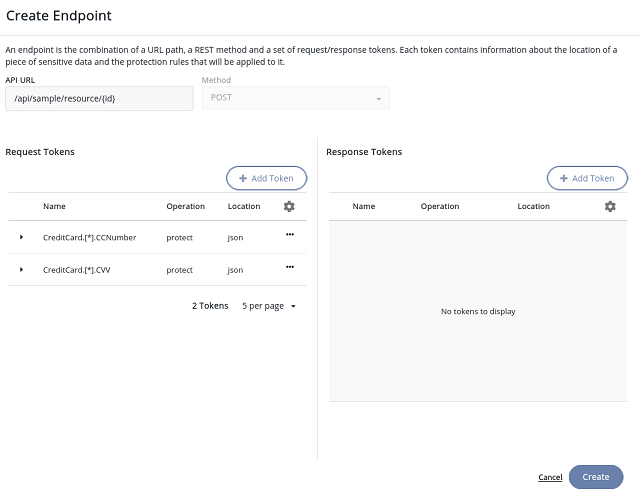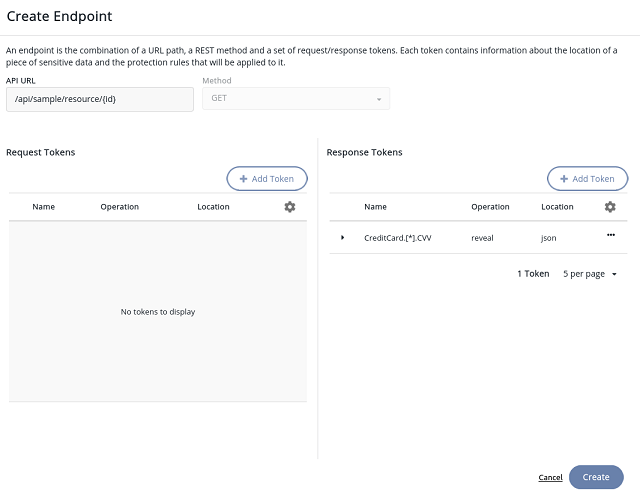Defining Applications
To define an application:
Log on to the CipherTrust Manager GUI as administrator.
Open Application Data Protection.
In the left pane, click Applications. The list of applications is displayed on the screen.
On the Applications page, click Add Application. The Add Application wizard is displayed. Follow the steps to complete the setup.
c. Create and Associate Policy
d. Confirmation
Add General Info
Specify a unique Name for the application.
Select Connector Type as DPG from the drop-down list.
Click Next to go to the Settings screen.
Note
Ensure the NAE interface with TLS, verify client cert, user name taken from client cert, auth request is optional mode is created and the Allow unregistered clients check-box is selected on the CipherTrust Manager. Refer to CipherTrust Manager Interfaces for detailed instructions.
Configure Parameters
On the Settings screen, configure the following parameters.
Network Configuration Parameter
Field Description Mandatory Default NAE Interface Port Select interface of the NAE server.
Only the interfaces with TLS, verify client cert, user name taken from client cert, auth request is optional mode are supported.
The firewall rules for this interface must allow communication.Yes No default After selecting the NAE interface, you can choose to ignore the rest of the configurations and instead, use the default values to define your application. To do so, click Next.
CA Parameter
Field Description Mandatory Default Select a local CA Authenticates the user defined in the Common Name. The CA must be associated with the interface selected in the previous step. Yes CipherTrust Root CA CSR Parameters
Field Description Mandatory Default Common Name Select the user from the drop-down list. This is the DPG user who will interact with CM.
— For DPG 1.2 and lower versions, NAE-XML interface is used.
— For DPG 1.3 and higher versions, REST interface is used.
Note: The selected user must exist in the root domain.Yes No default City Name of the city. Yes No default Country Name of the country. Yes No default State Name of the state. Yes No default Organization Name Organization name. Yes No default Organization Unit Organization unit. Yes No default Email Valid email id. Yes No default Certificate Duration Validity period of a client certificate. Yes 730 Authentication Method
Field Description Mandatory Default Scheme Name Authentication method used to validate the identity of the application users.
Following methods are allowed:
— Basic: In this scheme, username and password are passed into the authorization request header. The username and password are encoded in Base64 format.
— Bearer: In this scheme, a security token (a cryptic string) is granted to the application users. The application user must send this token in the authorization request header when making any reveal request to DPG.Yes Basic Token Field Name of the field that contains the username in authorization token based on which the level of access control over reveal operation will be identified. Required when Beareris selected as the authentication method.No default Logging
Field Description Mandatory Default Log Level The level of logging to determine verbosity of client logs.
Options
— INFO
— WARN
— ERROR
— DEBUGYes WARN Log Type Type of the log. The log type for DPG is Console. Yes Console (not configurable) Local Encryption Parameters
Field Description Mandatory Default Symmetric Key Cache Enabled Determines whether the symmetric key caching feature is enabled. Yes Always enabled (not configurable) Symmetric Key Cache Expiry Determines the minimum amount of time a key can be cached. Yes 43200 Connection Configuration
Field Description Mandatory Default Maximum Idle Connection Specifies the maximum number of idle (keep-alive) connections for all hosts. A value of 0 means no limit. Yes 10000 Maximum Idle Connection Per Host Specifies the maximum idle (keep-alive) connections to keep for each host. Yes 10000 Dial Timeout Specifies the maximum duration (in seconds) the DPG server will wait for a connection with the Application Server to succeed. Yes 10 Dial Keep Alive Specifies the interval (in seconds) between keep-alive probes for an active network connection. Yes 10 Connection Idle Timeout Specifies the duration for which a connection is allowed to be idle in the connection pool before it gets automatically closed. No 600000 Connection Retry Interval Specifies the time to wait before trying to reconnect to a disabled server. Yes 600000 Connection Timeout Connection timeout value for clients. Yes 60000 Connection Read Timeout Read timeout value for clients. Yes 7000 Size of Connection Pool The maximum number of connections that can persist in a connection pool. Yes 300 Load Balancing Algorithm Determines how the client selects a Key Manager from a load balancing group.
Options
— round-robin
— randomYes round-robin Heartbeat Interval Time interval (in seconds) after which the client needs to send heartbeat notification to the CipherTrust Manager to get updated policies and configurations. Yes 300 Heartbeat Timeout Count Number of missed heartbeats after which the client marks a CipherTrust Manager inactive. Yes -1 Tip
Heartbeat is a mechanism that notifies a client about any change in policies and configurations. The client sends the heartbeat to the CipherTrust Manager indicating that it is alive. In response, the CipherTrust Manager notifies client about any changes in the configurations and policies. To know more about the heartbeat parameters, refer to Heartbeat Configuration.
SSL Configuration
Field Description Mandatory Default TLS Enabled Determines whether to enable TLS. If check-box is selected, DPG will communicate with the upstream server over TLS else, TCP will be used. Yes Not selected (not configurable) TLS Skip Verify This field is always selected; DPG doesn't verify the upstream server certificates. Yes Always selected (not configurable)
Click Next to go to the Policy page.
Note
Before moving to next step, we recommend you to read about DPG Policies.
Create and Associate Policy
On the DPG Policy page, click Add Endpoint.
On the Create Endpoint screen, perform the following steps:
Enter the API URL. This is the URL of the application for which the DPG will protect the data.
Select Method from the drop-down list. Supported methods are:
POST
GET
PUT
PATCH
DELETE
Note
You must configure JSON path/URL parameters separately for each method.
Click Add Token to configure JSON path/URL. For same method, you can configure Request and Response simultaneously.
On the Create Token in Request screen, enter/select the following details.
Field Description Name Specify the complete JSON path/URL parameters to be protected/revealed. Location Location of the data to be protected/revealed.
Possible options are:
— JSON: If data to be protected is in JSON body.
— URL: If data to be protected is in URL parameters.Operation Cryptographic operation to be performed.
Possible options
— Protect
— RevealProtection Policy Select the protection policy form the drop-down list. If protection policy doesn't exist, click Add Protection Policy and click Select. Refer to Managing Protection Polices for details. External Version Header Specify the name of the parameter that will store the version header details (type, protection policy version, and key version). This parameter appears on the UI only when the selected protection policy uses external version header. Access Policy This parameter appears on the UI if operation type is Reveal. Select the access policy from the drop-down list. If access policy doesn't exist, click Add Access Policy and click Select. Refer to Managing Access Policies for details. If the JSON body has an array of objects, specify the sensitive tokens in the format shown in the below example:
{ "Name": "John", "CreditCard":[ { "CCNumber": "1234-5678-9012-3456", "CVV": "123", "Expiry": "12/03" } ], "Amount" : "250" }In this example, CreditCard is the array of objects (CCNumber, CVV, Expiry). To protect/reveal CCNumber, specify the token as
CreditCard.[*].CCNumberin the request/response of the DPG policy. Similarly, to protect/reveal CVV, use the following format:CreditCard.[*].CVV.Caution
If a set of data is already protected with a protection policy, ensure to reveal the data with the same protection policy.
Click Create. The newly created policy is listed on the DPG Policy page.
Now, to configure JSON path/URL parameters for other methods, click Add Endpoint and repeat steps a to g else, click Next to go to the Confirmation screen.
The below diagrams show that different methods require separate endpoint configurations.


Confirmation
On the Add Application page, verify the application details. The Confirmation screen displays general information, settings, and DPG policy.
If you want to modify any detail, click Edit and update the details.
Click Add. A message stating, Application created successfully is displayed on the screen. At this step, a Registration Token is generated. The clients will use this token to get registered on the CipherTrust Manager. To view the registration token, click here.
Click Close to exit the setup. The newly defined application is added to the list of Applications.

